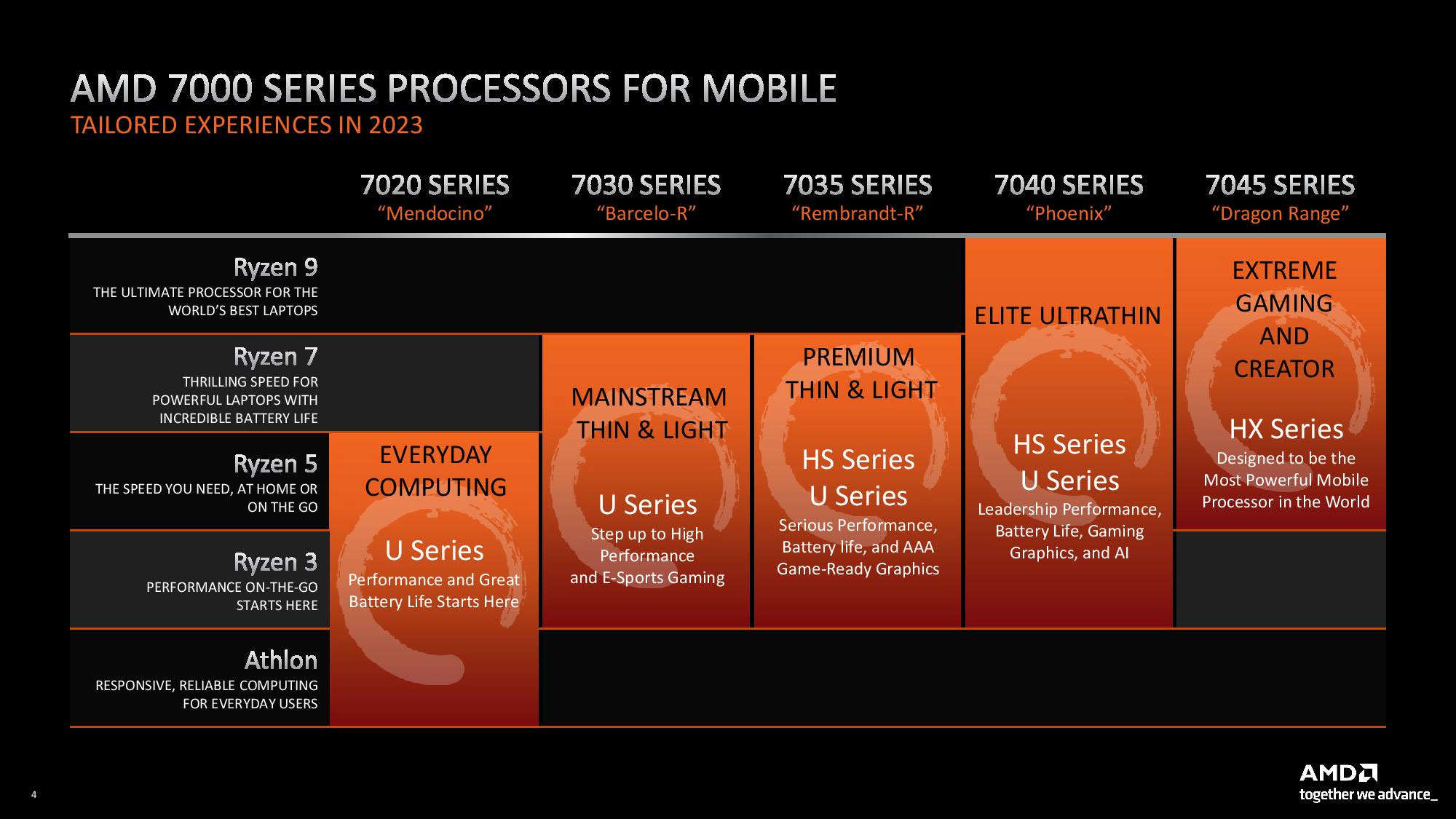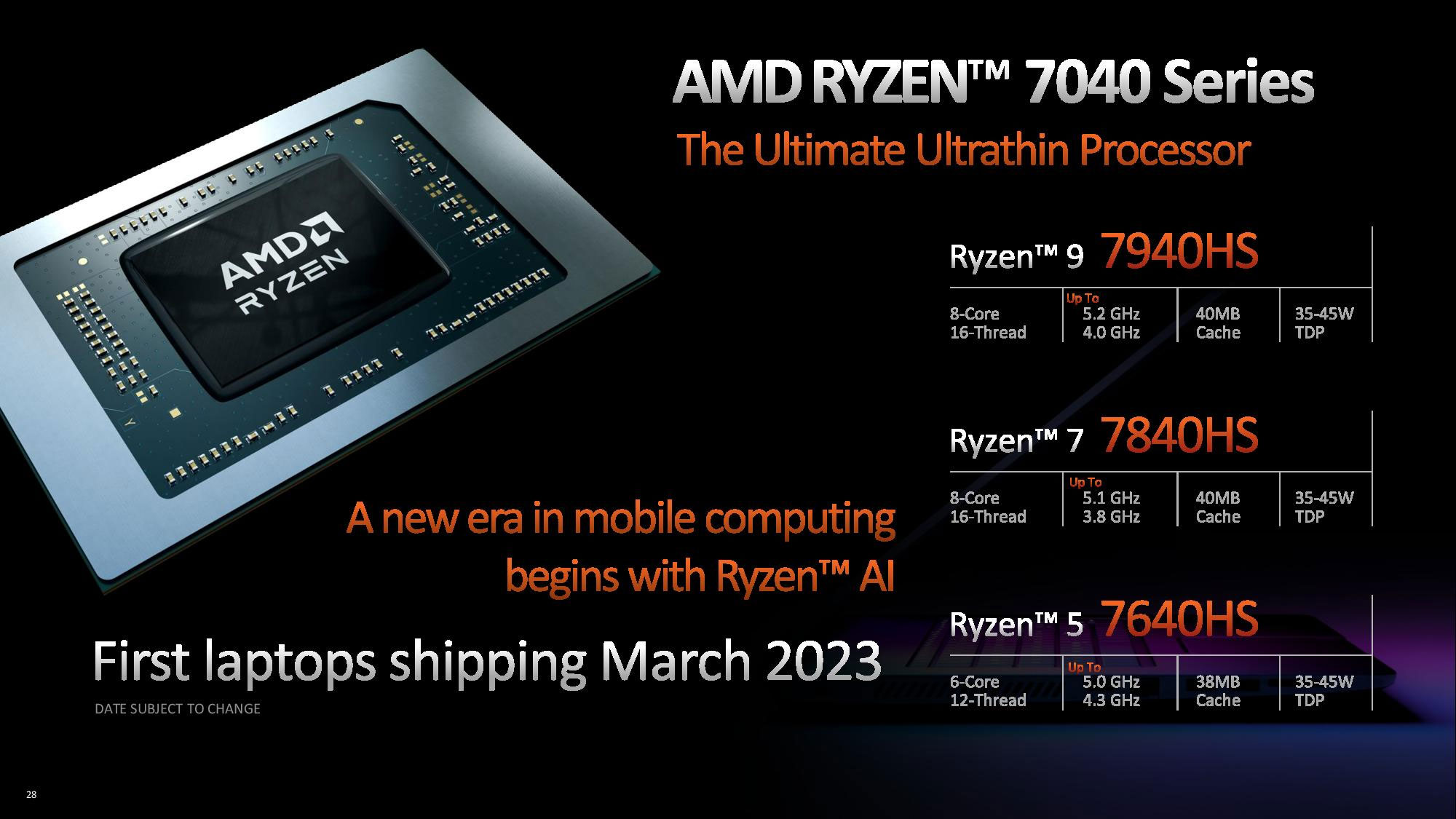AMD Ryzen 7040 Phoenix Mobile Specs Show No Sign of PCIe 5.0
PCIe 4.0 is the limit for this Zen 4 with RDNA 3 laptop processor.
At CES 2023, AMD took the wraps off five new 7000 Series processor families destined for laptops in the coming months. One of the most interesting families was the Ryzen 7040 Series ‘Phoenix’ chips as, based on the outline specs shared by AMD, they were the only new laptop APUs that feature the most modern charms of Zen 4 CPU cores and RDNA 3 graphics. Now an official spec sheet for the AMD Ryzen 7 7840H shows a lot more detail for one of the Phoenix family members. And it's notable for its lack of PCIe 5.0 support.


If you hit the AMD spec link in the intro (official AMD's Chinese site), you will see that the 7840H features PCIe 4.0, with 20 native lanes, which all are usable by components such as graphics and storage. According to AMD, Phoenix chips are destined for ‘Ultimate Ultrathin’ laptops, and while many won’t feature dedicated GPUs, instead relying on the decent RDNA 3 onboard graphics, there is still a full PCIe 4.0 x16 interface available. That leaves a PCIe 4.0 x4 link for a CPU-attached M.2 NVMe slot.
On the topic of the onboard RDNA 3 graphics, the best Phoenix chips will feature 12 CUs (768 stream processors), running at up to 2.9GHz; this configuration is dubbed Radeon 780M by AMD. We have already seen some early 3DMark Time Spy benchmarks of this iGPU in action, and it was about 25% faster than its predecessor (RDNA 2 architecture Radeon 680M). In those tests, it was more or less on par with the GeForce RTX 2050 laptop GPU.
Another interesting aspect of AMD Phoenix is its memory support. The Ryzen 7 7840H specs show that it supports both LPDDR5 and LPDDR5x Ram types, and the native speeds supported are DDR5-5600 and LPDDR5-7600. Meanwhile, the memory controller appears to facilitate a capacity boost, with Phoenix chips supporting up to 256GB of RAM. That's another feature that appears to be an improvement on the ‘Ultra Enthusiast’ targeted Ryzen 7045 ‘Dragon Range’ laptop processors.


Some other specs confirmed by the Chinese product information sheets is the CCD die size, 178mm2. The L3 cache configuration in this instance is 16MB. Most of the other specs have been well-known for the last month, as you can see from the embedded slides from AMD’s CES 2023 presentation, above. Laptops featuring these processors should be on shelves starting in March.
Remember that AMD Ryzen 7045 ‘Dragon Range’ chips will be the most powerful CPUs in the laptop range, with up to 16C / 32T Zen 4 cores, with up to 80MB cache. However, this processor will feature a small RNDA 2 iGPU, as it will invariably feature in gaming and creator laptops with strong discrete graphics solutions. Also, contrasting with Phoenix, Dragon Range has 28 PCIe Gen 5 lanes (with 24 usable, therefore enough for an x16 GPU and a pair of x4 SSDs).
Get Tom's Hardware's best news and in-depth reviews, straight to your inbox.

Mark Tyson is a news editor at Tom's Hardware. He enjoys covering the full breadth of PC tech; from business and semiconductor design to products approaching the edge of reason.
-
cknobman Looking forward to the 780m graphics, not much need for dedicated graphics whit that.Reply -
Sleepy_Hollowed I mean, it's not a power laptop, not too surprising, putting that in does not make sense as it drives the cost and would not make much sense.Reply
My desktop has PCIE 4.0 and I use every bit of it with power use, so it's not like it's an issue at the moment.
Let's hope the power usage vs performance is killer though, that's all everyone wants from a portable laptop. -
Umfriend Reply
Indeed, and then in a design that is light but not necessarily thin so we can have ports, SO-DIMM, 2 M.2 2280 SSDs and real quiet yet, for a 15-28W CPU, great performance. Imagine that with a 70Wh battery.cknobman said:Looking forward to the 780m graphics, not much need for dedicated graphics whit that. -
Karl_Schwarzschild One thing about the 780M still puzzles me. It is supposed to have 12 CUs. In RDNA3 there are 128 shaders/CU (or 64 shaders with 2 FP Units) which basically doubles the throughput as we saw with the 7900 XTX. That translates into 1536 Shaders for the 780M vs 768 for the 680m, because RDNA2 has only 64FPs/CU.Reply
+Higher Clocks +DDR5
Shouldn't that be more like +125-150% compared to the 680M?
Early leaks were also hinting 3600M like performance for the 780M. 2050Mish is pretty disappointing now.
And that's not only me. Here they also list it as 8,9 FP32 TFLOPs vs 3,4 for the 680M. -
Avro Arrow Why is this article talking about PCI-Express v4.0 like it's ancient tech? IIRC, it was first available (for AM4) on the X470 platform. It's still blazingly fast and I know that because my gaming NVMe drives are just PCI-Express v3.0 and they're more than fast enough to reduce load times to a few seconds. Let's be honest, does anything exist yet that's fast enough to be bottlenecked by PCI-Express v4.0? I really don't think so, at least, not in the consumer market.Reply
It could be that PCI-Express v5.0 would be nothing more than an added expense that pays no dividends so it would be smart not to bother with it yet. It's like, I was personally not the least bit impressed with the fact that the Radeon RX 7000-series has DP2.1 while the GeForce RTX 4000-series doesn't. Since neither series of cards is even remotely potent enough to use that kind of bandwidth, there was no point to it.
If AMD incurred any extra expense in supporting DP2.1, it was nothing more than a dumb marketing stunt that paid no real dividends. If it wasn't more expensive to implement, then it was a mistake for nVidia to not do it.
Now, I may think that Jensen Huang is human garbage but he's not the least bit stupid. If nVidia didn't implement DP2.1, it's probably because it did cost more and wasn't worth it.
Complaining about not using a cutting-edge technology that's probably expensive and has no real added benefit is both childish and stupid so I really don't care. -
Kamen Rider Blade Reply
The GPU Frequency in APU's are very limited for power reasons, so even if you have the hardware, don't expect the clocks to go so high for power saving reasons.Karl_Schwarzschild said:One thing about the 780M still puzzles me. It is supposed to have 12 CUs. In RDNA3 there are 128 shaders/CU (or 64 shaders with 2 FP Units) which basically doubles the throughput as we saw with the 7900 XTX. That translates into 1536 Shaders for the 780M vs 768 for the 680m, because RDNA2 has only 64FPs/CU.
+Higher Clocks +DDR5
Shouldn't that be more like +125-150% compared to the 680M?
Early leaks were also hinting 3600M like performance for the 780M. 2050Mish is pretty disappointing now.
And that's not only me. Here they also list it as 8,9 FP32 TFLOPs vs 3,4 for the 680M.
Short of being plugged into the wall, you're only going to get so much performance out of it when in battery mode.
Remember, AMD is focused on "Power Savings", not giving you the maximum performance out of 12 CU's while in battery mode.
Radeon RX 6400 performance built into your APU isn't bad, considering it's a "Budget GPU" built into your APU.
You got to remember that AMD's 12 CU's of RDNA3 for their mobile line is a step up from 8 CU's of VEGA graphics. -
Kamen Rider Blade Reply
Because they want to "Keep up with the latest tech", even if the application doesn't always make sense like in mobile where higher PCIe spec would sap more energy out of a limited battery.Avro Arrow said:Why is this article talking about PCI-Express v4.0 like it's ancient tech? IIRC, it was first available (for AM4) on the X470 platform. It's still blazingly fast and I know that because my gaming NVMe drives are just PCI-Express v3.0 and they're more than fast enough to reduce load times to a few seconds. Let's be honest, does anything exist yet that's fast enough to be bottlenecked by PCI-Express v4.0? I really don't think so, at least, not in the consumer market.
It could be that PCI-Express v5.0 would be nothing more than an added expense that pays no dividends so it would be smart not to bother with it yet. It's like, I was personally not the least bit impressed with the fact that the Radeon RX 7000-series has DP2.1 while the GeForce RTX 4000-series doesn't. Since neither series of cards is even remotely potent enough to use that kind of bandwidth, there was no point to it.
If AMD incurred any extra expense in supporting DP2.1, it was nothing more than a dumb marketing stunt that paid no real dividends. If it wasn't more expensive to implement, then it was a mistake for nVidia to not do it.
Now, I may think that Jensen Huang is human garbage but he's not the least bit stupid. If nVidia didn't implement DP2.1, it's probably because it did cost more and wasn't worth it.
Complaining about not using a cutting-edge technology that's probably expensive and has no real added benefit is both childish and stupid so I really don't care. -
zecoeco It's a bit weird that AMD changed specs of few products they announced on CES.Reply
This includes Ryzen 780M GPU that I spotted few weeks ago as being the world's first GPU that runs at 3000MHz at stock settings.
I was very impressed. But then later, for some reason, they changed that to 2900MHz. I attached the screenshot that I captured few weeks ago.